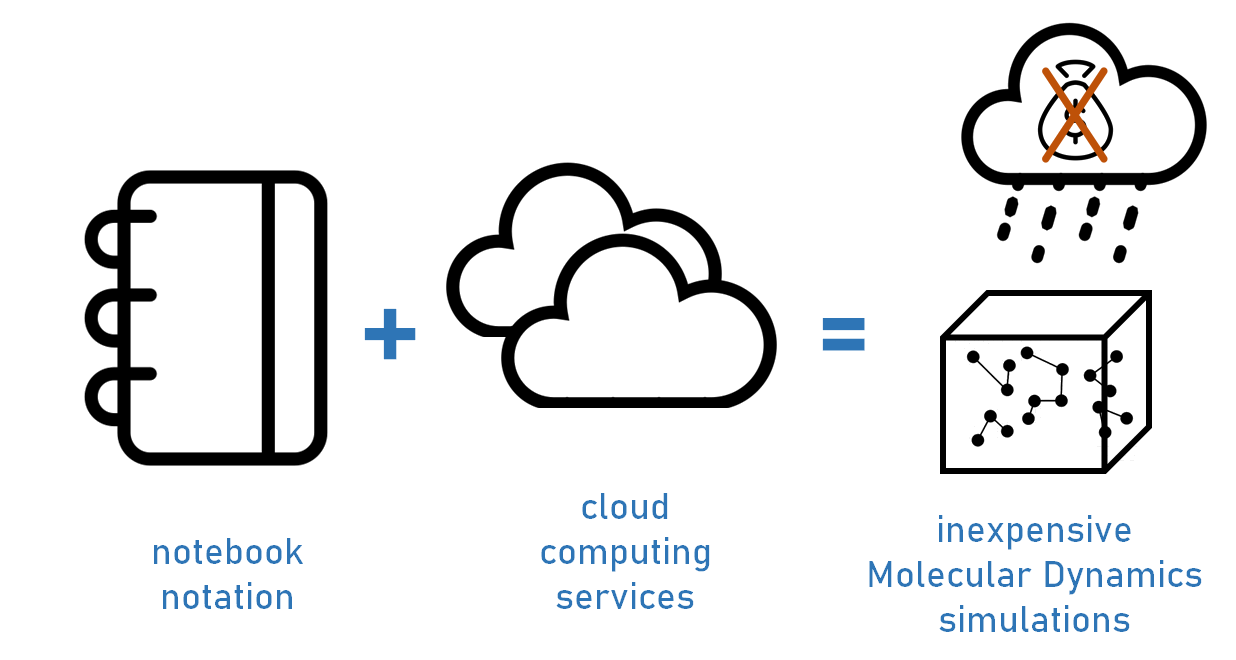Making it rain
Cloud-based molecular simulations for everyone
Hello there!
Welcome to Making it rain page, here you can find a Jupyter notebook scripts for running Molecular Dynamics (MD) simulations using OpenMM engine and AMBER and CHARMM force fields files on Google Colab. This site is a supplementary material of the paper “Making it rain: Cloud-based molecular simulations for everyone” and we encourage you to read it before using this pipeline.

The main goal of this work is to demonstrate how to harness the power of cloud-computing to run microsecond-long MD simulations in a cheap and yet feasible fashion.
Important: We’ve updated the notebooks to CondaColab. Now, all the dependencies will be installed faster than before (less than half of the previous time). You will see a CondaColab cell, just run and wait a few seconds, the session will restart and this is normal and expected. After that, you can continue running the cells like normal. Do not use the Run all option. Run the condacolab cell individually and wait for the kernel to restart. Only then, you can run all cells if you want. Thank you for your support.
- AMBER
-
Using AMBER to generate topology and to build the simulation box - CHARMM
-
Using inputs from CHARMM-GUI solution builder - AlphaFold2+MD
-
Using AlphaFold2_mmseqs2 to generate protein model + MD simulation using AMBER to generate topology and to build simulation box
UPDATE (October 2021)
- Protein-Ligand simulations
-
Using AMBER to generate topology and to build the simulation box and for the ligand using GAFF2 force field - Using AMBER Inputs
-
Using inputs from AMBER suite of biomolecular simulation program - Using GROMACS Inputs
-
Using inputs from GROMACS biomolecular simulation package (AMBER, CHARMM and OPLS force fields are compatible)
UPDATE (March 2022)
- RESP Partial Charges
-
Using a SMILES as input and outputs a mol2 file with RESP derived partial charges. Options for setting method (HF, B3LYP, ...), basis set (3-21G, 6-31G*) and singlepoint or geometry optimization are available - Small Molecules MD
-
Using a SMILES as a input, geometry optimization with TorchANI and topology with AMBER (GAFF2 force field) - GLYCAM
-
Using inputs from GLYCAM server
UPDATE (August 2022)
UPDATE (March 2024)
- Protein-Membrane simulations
-
Using OpenFF to generate the topology and build the simulation box for protein-membrane systems with AMBER force fields. - Martini+cg2all
-
Utilizing Vermouth, the Python library that powers Martinize2, to generate the topology and build the simulation box for protein systems using Martini force fields. Additionally, employing cg2at to predict all-atom trajectories from coarse-grained (CG) representations. - AMBER Mutations
-
Performing mutations on protein/nucleic acid systems and utilizing AMBER to generate the topology and build the simulation box.
UPDATE (March 2025)
First, we made MD simulations rain down from the cloud. Now, we’re bringing deep learning into the mix!
- Subsampled AlphaFold2
-
Colab notebook for running the subsampled AlphaFold2 approach for predicting protein conformational ensembles. - Biomolecular Emulator
-
Biomolecular Emulator (BioEmu), a model that samples from the approximated equilibrium distribution of structures for a protein monomer, given its amino acid sequence. - Biomolecular Emulator+HPACKER
-
Biomolecular Emulator (BioEmu), a model that samples from the approximated equilibrium distribution of structures for a protein monomer, given its amino acid sequence and side-chain reconstruction, using HPacker.
Want to try MD simulation on NAMD using Google Colab? Mostafa Sayed create a colab notebook for running MD simulations using NAMD and CHARMM-GUI inputs.
Bugs
- If you encounter any bugs, please report the issue here.
Acknowledgments
- We would like to thank the BioEmu team for developing an excellent and open source model.
- We would like to thank the Psi4 team for developing an excellent and open source suite of ab initio quantum chemistry.
- We would like to thank the Roitberg team for developing the fantastic TorchANI.
- We would like to thank the OpenMM team for developing an excellent and open source engine.
- We would like to thank the AlphaFold team for developing an excellent model and open sourcing the software.
- We would like to thank the ChemosimLab (@ChemosimLab) team for their incredible ProLIF (Protein-Ligand Interaction Fingerprints) tool.
- Credit to Sergey Ovchinnikov (@sokrypton), Milot Mirdita (@milot_mirdita) and Martin Steinegger (@thesteinegger) for their fantastic ColabFold.
- Making it rain by Pablo R. Arantes (@pablitoarantes), Marcelo D. Polêto (@mdpoleto), Conrado Pedebos (@ConradoPedebos) and Rodrigo Ligabue-Braun (@ligabue_braun).
- Also, credit to David Koes for his awesome py3Dmol plugin.
- Finally, we would like to thank Professor Giulia Palermo for her support and thoughtful comments in the development of the present work.
Do you want to cite this work?
Arantes P.R., Depólo Polêto M., Pedebos C., Ligabue-Braun R. Making it rain: cloud-based molecular simulations for everyone. Journal of Chemical Information and Modeling 2021. DOI: 10.1021/acs.jcim.1c00998.